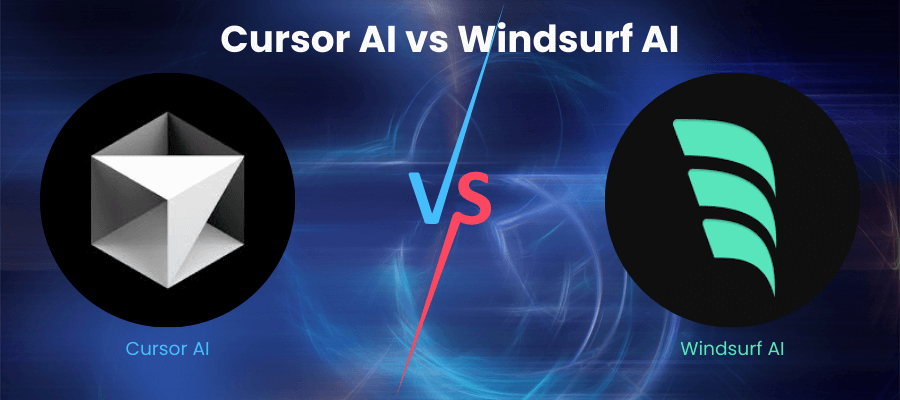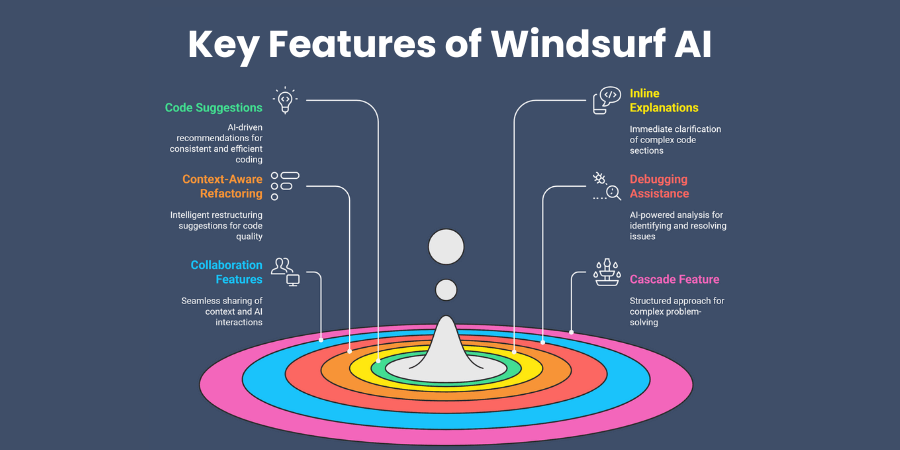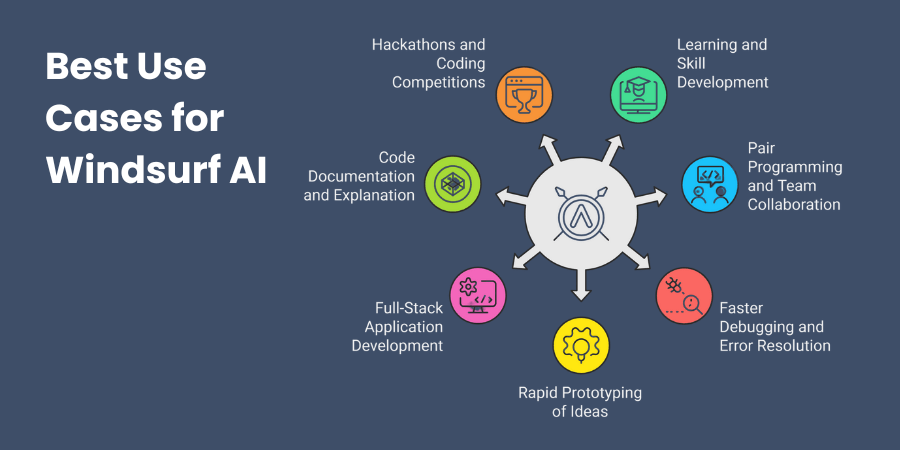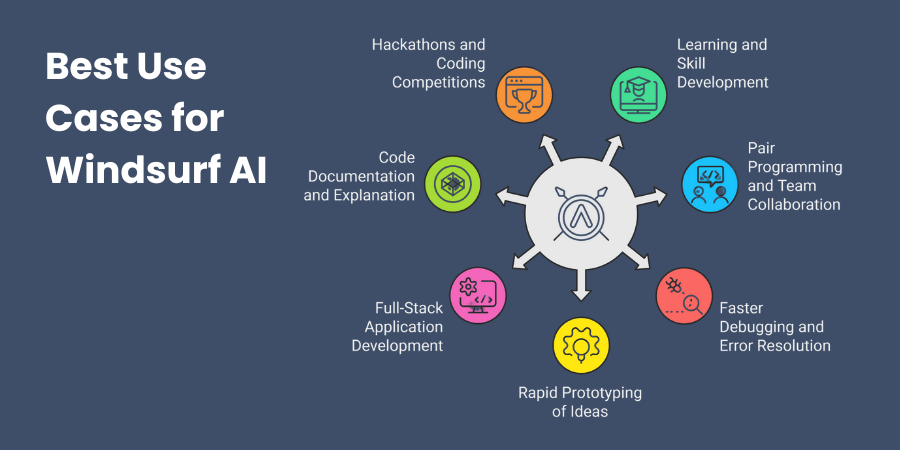Cursor AI vs Windsurf AI: The Future of AI-Powered Code Editors in 2025

Table of Contents
The landscape of software development has undergone a remarkable transformation in 2025, with AI-powered code editors leading this revolution. Cursor AI vs Windsurf AI represents the cutting edge of this technological advancement, offering developers unprecedented assistance in writing, debugging, and shipping code. These intelligent tools have fundamentally changed how programmers approach their craft, automating repetitive tasks and providing contextual suggestions that enhance productivity.
Cursor AI vs Windsurf AI stands at the forefront of this evolution, with both platforms leveraging advanced language models to streamline development workflows. The emergence of these AI coding assistants has coincided with significant improvements in underlying AI models, allowing for more accurate code generation and deeper understanding of programming contexts.
For developers navigating this new ecosystem, choosing between these powerful tools requires understanding their distinct approaches, capabilities, and limitations. Each platform offers unique advantages that cater to different development styles, project requirements, and team structures.
Key Takeaways
- Readers will understand how Cursor AI and Windsurf AI are reshaping software development with AI-powered coding assistance in 2025.
- Compare the unique strengths of each platform—Cursor for rapid prototyping and multi-language coding, Windsurf for enterprise collaboration.
- Identify the key differences in usability, integrations, debugging, scalability, and UI/UX to determine which fits specific workflows.
- Discover where they overlap, including AI-driven code suggestions, debugging support, and productivity-focused coding enhancements.
- Evaluate best use cases—from startups and solo developers using Cursor to enterprises and teams benefiting from Windsurf’s collaboration tools.
- Choose the right platform by considering project complexity, team size, budget, and long-term development goals.
Table of Contents
What is Cursor AI?
Cursor AI emerged as a pioneering AI-powered code editor built on the foundation of Visual Studio Code. This innovative tool combines familiar IDE functionality with advanced AI capabilities powered by leading language models. Developed by a team of former Scale AI engineers, Cursor has quickly gained traction among developers seeking to enhance their coding efficiency.

The platform distinguishes itself through its seamless integration of AI assistance into the coding workflow. Cursor AI functions as a comprehensive development environment rather than just a plugin or extension. This integrated approach allows for deeper context awareness when generating code suggestions or performing complex operations.
Cursor has attracted a substantial user base due to its ability to understand codebases holistically. The editor can analyze entire projects to provide more relevant suggestions and solutions. This project-wide understanding enables developers to receive assistance that considers the broader context of their code.
Key Features of Cursor AI
Cursor AI offers an impressive array of capabilities that transform the coding experience. Natural language to code generation stands out as a cornerstone feature, allowing developers to describe functionality in plain English and receive working code implementations.

The editor’s intelligent auto-completion extends beyond traditional IDE suggestions. Cursor predicts multiple lines of code based on context, understanding function intent and implementing appropriate patterns.
Project-wide AI search represents another powerful feature in Cursor’s toolkit. Developers can ask questions about their codebase in natural language, with Cursor returning relevant code sections and explanations.
Debugging support in Cursor AI helps identify and fix errors through natural language interactions. The system can explain error messages, suggest fixes, and even implement corrections when requested.
Multi-language compatibility ensures Cursor works effectively across various programming environments. The editor supports all major languages including Python, JavaScript, TypeScript, Java, C++, and Rust.
Cursor’s chat interface facilitates extended conversations about code, allowing developers to refine requirements and solutions iteratively. This conversational approach maintains context throughout complex problem-solving sessions.
What is Windsurf AI?
Windsurf AI represents a new generation of AI-native code editors designed from the ground up for AI-assisted development. Unlike tools that add AI capabilities to existing editors, Windsurf was conceived with AI collaboration at its core. This fundamental difference shapes its entire user experience and feature set.

The platform emerged from a vision to create a more intuitive coding environment where AI serves as a natural extension of the developer’s thought process. Windsurf positions itself as a comprehensive development environment that seamlessly blends human creativity with AI capabilities.
Windsurf distinguishes itself through its streamlined interface that prioritizes AI interactions. The design philosophy emphasizes reducing friction between idea conception and code implementation.
The platform supports a wide range of development workflows across multiple programming languages and frameworks. Its architecture allows for contextual understanding of projects, enabling more relevant suggestions and assistance.
Key Features of Windsurf AI
Windsurf AI delivers powerful AI-driven code suggestions that understand project context and developer intent. The system analyzes existing code patterns to provide recommendations that maintain consistency with established practices.

Inline explanations represent a standout feature in Windsurf’s toolkit. The editor can provide immediate clarification of complex code sections without disrupting workflow. These explanations adapt to developer expertise level, offering more detailed guidance for unfamiliar patterns or technologies.
Context-aware refactoring capabilities help improve code quality through intelligent restructuring suggestions. Windsurf identifies opportunities for optimization, simplification, or pattern application across files.
Debugging assistance in Windsurf combines traditional debugging tools with AI-powered analysis. The system can identify potential issues, explain error conditions, and suggest remediation strategies.
Collaboration features enable team members to share context and AI interactions seamlessly. Windsurf maintains conversation history and code evolution, allowing team members to understand decision processes.
Windsurf’s Cascade feature provides multi-step reasoning for complex problems, breaking solutions into logical components. This structured approach helps developers understand solution pathways and modify intermediate steps as needed.
The platform’s integration capabilities connect with version control systems, issue trackers, and documentation tools. These connections maintain context across the development ecosystem, reducing friction between different aspects of the software lifecycle.
Windsurf AI vs. Cursor AI: Head-to-Head Comparison Table
| Feature Category | Cursor AI | Windsurf AI |
| Usability | Technical interface with more controls | Streamlined interface prioritizing simplicity |
| IDE Integration | Built on VS Code with familiar workflows | Custom environment with unique interaction model |
| Supported Languages | Comprehensive support for 15+ languages | Strong support for 12+ languages |
| Collaboration Features | Basic sharing capabilities | Advanced team features with shared context |
| Debugging | Strong error explanation and fix suggestions | Integrated debugging with visual analysis tools |
| Pricing | $20/month for Pro, $40/month for Team | $15/month for Pro, $35/month for Team |
| Scalability | Enterprise options with custom pricing | Enterprise platform with security features |
| AI Model | Claude 3.5 Sonnet with customizations | Claude 3.5 Sonnet with proprietary enhancements |
| Code Generation | Excellent for complex algorithms | Superior for maintaining project consistency |
| Learning Curve | Moderate learning curve | Gentler onboarding experience |
| Documentation | Comprehensive with examples | Interactive tutorials and guidance |
Key Differences Between Windsurf and Cursor AI
The speed and responsiveness between these platforms reveals meaningful distinctions in their design philosophy. Cursor AI typically processes requests faster for individual code snippets, excelling at quick iterations. Windsurf AI may take slightly longer for initial responses but often provides more contextually relevant solutions that require fewer refinements.
UI/UX differences represent perhaps the most immediately noticeable distinction between these tools. Cursor maintains a traditional code editor layout with AI features accessible through commands and panels. Windsurf embraces a more fluid interface where AI interaction feels more conversational and integrated into the coding workflow.
Integration capabilities diverge significantly between the platforms. Cursor leverages its VS Code foundation to support thousands of extensions and tools in the existing ecosystem. Windsurf offers fewer integrations but provides deeper connections with supported tools, particularly for team collaboration and project management systems.
Enterprise adoption patterns show Cursor gaining traction in organizations with established VS Code workflows seeking to enhance productivity. Windsurf has found stronger adoption in teams building new projects or those prioritizing collaboration features.
Performance on large codebases reveals another key difference. Cursor excels at navigating and understanding massive repositories with millions of lines of code. Windsurf performs better at maintaining consistent understanding across multiple files in medium-sized projects.
Similarities Between Windsurf and Cursor AI
Both platforms deliver powerful AI-powered code assistance that fundamentally transforms the development experience. Each tool can generate complete functions, suggest improvements, and explain complex code sections.
Support for multiple programming languages remains comprehensive across both platforms. Each tool handles popular languages like Python, JavaScript, TypeScript, and Java with excellent accuracy.
Debugging features in both systems help developers identify and resolve issues efficiently. Each platform can explain error messages, suggest potential fixes, and help trace program execution.
Productivity improvements represent a shared strength, with studies showing 20-40% efficiency gains for experienced developers using either tool. Both platforms eliminate repetitive coding tasks, accelerate documentation creation, and simplify complex implementations.
Integration with version control systems enables both tools to understand project history and context. Each platform can analyze commit patterns, understand code evolution, and incorporate this knowledge into suggestions.
Regular updates and improvements characterize both platforms, with new features appearing monthly. Each development team actively incorporates user feedback and adapts to emerging needs.
Best Use Cases for Windsurf AI
Windsurf AI has quickly emerged as a powerful AI coding assistant, helping developers work smarter and faster. Its intuitive design, real-time collaboration, and AI-powered coding support make it ideal for various scenarios. Here are the best use cases where Windsurf AI delivers the most impact:

1. Learning and Skill Development
Windsurf AI is an excellent tool for students and self-learners. It explains code, suggests improvements, and provides real-time guidance. Beginners can practice programming without feeling overwhelmed by errors or complex debugging tasks.
2. Pair Programming and Team Collaboration
Teams benefit from Windsurf’s collaborative environment. Multiple developers can edit, review, and test code simultaneously. The AI acts like a smart coding partner, reducing coordination gaps and boosting productivity.
3. Faster Debugging and Error Resolution
Windsurf AI detects bugs, explains problems, and even suggests fixes instantly. Developers save hours spent searching forums or debugging manually. This is especially valuable in time-sensitive projects.
4. Rapid Prototyping of Ideas
For startups and innovators, Windsurf enables quick prototyping. Developers can test concepts faster with AI-generated suggestions, saving effort during the early design phase.
5. Full-Stack Application Development
Windsurf supports both frontend and backend workflows. Developers can seamlessly switch between building interfaces and managing server logic within one environment.
6. Code Documentation and Explanation
The AI can generate clear documentation and explain complex code segments in plain language. This improves project handovers and supports knowledge sharing within teams.
7. Hackathons and Coding Competitions
In high-pressure coding events, Windsurf provides instant support through fast coding suggestions, bug detection, and idea testing. This gives teams a competitive edge.
Best Use Cases for Cursor AI
Cursor AI has quickly gained attention as a next-generation AI coding assistant, designed to enhance developer productivity and streamline workflows. With its advanced code understanding and intelligent suggestions, Cursor AI proves valuable across multiple scenarios. Here are the best use cases where it excels:

1. Accelerating Software Development
Cursor AI helps developers write code faster by suggesting context-aware completions and generating functions instantly. This reduces repetitive work and boosts efficiency.
2. Debugging and Error Fixing
The AI identifies bugs, highlights problem areas, and recommends fixes in real-time. This shortens debugging cycles and minimizes downtime.
3. Learning New Frameworks and Languages
Developers exploring new programming languages benefit from Cursor AI’s explanations and guided code generation. It lowers the learning curve significantly.
4. Building Complex Applications
From backend APIs to frontend interfaces, Cursor supports full-stack development. It adapts to complex workflows while assisting with structure and optimization.
5. Code Reviews and Quality Improvement
Cursor AI improves collaboration by suggesting cleaner syntax, optimized structures, and documentation. Teams can maintain consistency across large projects.
6. Rapid Prototyping and MVP Creation
Startups and entrepreneurs can quickly test product ideas. Cursor generates functional code blocks, allowing faster MVP development and market validation.
Note: Cursor AI performs best when given access to your entire project for maximum context awareness.
Which is Right for You?
| Developer Profile | Recommended Tool | Key Deciding Factors |
| Solo Developer | Cursor AI | Faster implementation speed, stronger VS Code integration |
| Small Team (2-5) | Either Option | Depends on collaboration needs and existing workflows |
| Medium Team (6-15) | Windsurf AI | Better collaboration features and shared context |
| Enterprise | Depends on needs | Cursor for VS Code shops, Windsurf for collaboration focus |
| Open Source Contributor | Cursor AI | Better GitHub integration and codebase navigation |
| Full-Stack Developer | Cursor AI | Stronger multi-language support and context switching |
| Specialized Developer | Depends on language | Check specific language support strength |
| Student/Learner | Windsurf AI | Better explanations and step-by-step reasoning |
Your development goals significantly influence which tool provides better value. Projects prioritizing rapid delivery benefit from Cursor’s speed and efficiency. Teams focused on code quality and maintainability often prefer Windsurf’s consistency enforcement and explanation capabilities.
Budget considerations may impact your decision, with Windsurf offering slightly lower entry pricing. However, feature requirements should typically outweigh small price differences when evaluating long-term productivity benefits.
Your development environment plays a crucial role in this decision. Teams heavily invested in VS Code ecosystems find Cursor’s familiar environment reduces adoption friction. Organizations seeking a fresh approach or struggling with existing tooling limitations may benefit from Windsurf’s reimagined interface.
Conclusion
The comparison between Cursor AI vs Windsurf AI reveals two powerful approaches to AI-assisted development with distinct strengths. Both tools represent the future of AI-first coding environments, fundamentally transforming how developers interact with code. They share core capabilities in code generation, explanation, and debugging assistance that deliver substantial productivity improvements. The 20-40% efficiency gains reported by users of both platforms justify their adoption for most development scenarios.
Your specific workflow requirements should guide your selection between these powerful tools. Consider your team size, collaboration needs, existing tooling investments, and development patterns. Both platforms offer free trials that provide the best mechanism for evaluating their impact on your specific environment.
Frequently Asked Questions
Can I use Cursor AI or Windsurf AI offline?
Both platforms require internet connectivity for their core AI features. Cursor offers limited offline functionality for basic editing without AI assistance. Windsurf requires a connection for all features. Neither platform supports fully offline AI capabilities due to the computational requirements of running large language models.
Do these tools work with proprietary or sensitive codebases?
Yes, both platforms offer enterprise options with enhanced security for sensitive code. Cursor provides private instances that keep code within your infrastructure. Windsurf offers enterprise deployments with customizable data retention policies. Both implement encryption and compliance features suitable for most security requirements.
Will using AI coding assistants make me a worse programmer?
Research suggests the opposite effect when these tools are used appropriately. Developers using AI assistants often learn new patterns and techniques through exposure to generated code. The key lies in understanding the generated code rather than implementing it blindly. Both platforms provide explanations that facilitate learning.
How accurate is the code generated by Cursor AI and Windsurf AI?
Both platforms generate functionally correct code approximately 85-90% of the time for standard tasks. Complex or specialized implementations may require refinement. Windsurf typically produces more consistent code aligned with existing project patterns. Cursor often generates more optimized implementations for algorithmic challenges.
Can these tools completely replace human programmers?
No, both tools function as assistants rather than replacements for human developers. They excel at implementing well-defined requirements and solving known problems. However, they lack the creativity, judgment, and contextual understanding necessary for high-level design decisions and novel problem-solving. Human oversight remains essential for quality software development.
Shaif Azad
Related Post
Top 10 AI Development Companies in New Jersey for Business
Are you searching for the perfect AI development partner in New Jersey? Have you wondered which...
Top 10 AI Development Companies in New Hampshire
Are you watching New Hampshire’s tech landscape transform before your eyes? Your state is quietly becoming...
Top AI Companies in Nebraska Every Business Should Know
Are you a Nebraska business owner wondering how artificial intelligence could transform your operations? Picture this...




